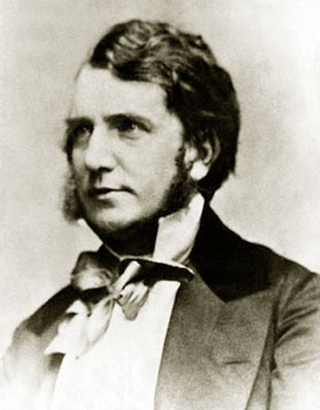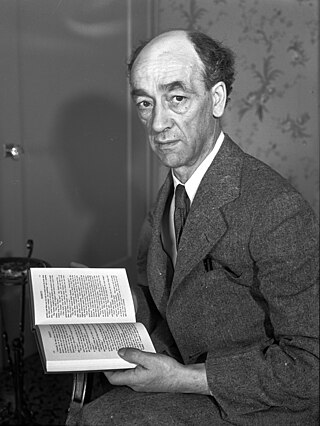Related Research Articles

Joseph Thomas Sheridan Le Fanu was an Irish writer of Gothic tales, mystery novels, and horror fiction. He was a leading ghost story writer of his time, central to the development of the genre in the Victorian era. M. R. James described Le Fanu as "absolutely in the first rank as a writer of ghost stories". Three of his best-known works are the locked-room mystery Uncle Silas, the vampire novella Carmilla, and the historical novel The House by the Churchyard.

William Carleton was an Irish writer and novelist. He is best known for his Traits and Stories of the Irish Peasantry, a collection of ethnic sketches of the stereotypical Irishman.

George William Russell, who wrote with the pseudonym Æ, was an Irish writer, editor, critic, poet, painter and Irish nationalist. He was also a writer on mysticism, and a central figure in the group of devotees of theosophy which met in Dublin for many years.

James Stephens was an Irish novelist and poet.
The Irish Literary Revival was a flowering of Irish literary talent in the late 19th and early 20th century. It includes works of poetry, music, art, and literature.
Desmond Hogan is an Irish writer. Awarded the 1977 Rooney Prize for Irish Literature and 1980 John Llewellyn Rhys Prize, his oeuvre comprises novels, plays, short stories and travel writing.
St Stanislaus College was a Jesuit boys boarding school, novitiate and philosophy school, in Tullabeg, Rahan, County Offaly. St Carthage founded a monastery of 800 monks there in 595 before founding his monastery in Lismore. The Presentation Sisters also have a convent in Rahan, Killina, which was founded at the same time as the Jesuits founded St Stanislaus College.
Daniel Corkery was an Irish politician, writer and academic. He is known as the author of The Hidden Ireland, a 1924 study of the poetry of eighteenth-century Irish language poets in Munster.
Thomas Caulfield Irwin was an Irish poet, writer, and classical scholar.
Matthias McDonnell Bodkin was an Irish nationalist politician and MP in the House of Commons of the United Kingdom of Great Britain and Ireland and Anti-Parnellite representative for North Roscommon, 1892–95, a noted author, journalist and newspaper editor, barrister, and County Court Judge for County Clare, 1907–24.
Michael Patrick O'Connor (1896–1967) was an Irish doctor, writer and broadcaster.
Desmond Clarke was an Irish librarian, writer and former president of the Library Association of Ireland. Clarke was the biographer of various Irish figures including Arthur Dobbs, Thomas Prior, and Marie-Louise O'Murphy.

Charlotte O'Conor Eccles (1863–1911) was an Irish writer, translator and journalist, who spent her working life in London. Aliens of the West (1904) was said to be among "the best modern books of short stories on Ireland yet written."
Philip Dixon Hardy (1794–1875) was an Irish poet, bookseller, printer, and publisher. He introduced the use of steam-powered printing presses in Ireland in 1833.

Patrick Kennedy was a folklorist from County Wexford, Ireland. An educator turned bookseller, who also contributed various articles and reviews as a writer, he eventually became best-known as a collector and publisher of Irish folktales and folklore, particularly from his native County Wexford.

Julia M. Crottie, sometimes seen as Julia Crotty, was an Irish novelist who detailed rural life in Ireland, writing during the late 19th and early 20th centuries.
Amy Corzine is an American-born fiction and non-fiction writer and poet. Her first book was a Cadogan travel guide to Ireland for families in which she included stories she wrote based on Irish folktales. After that, Watkins Publishing commissioned her for 'The Secret Life of the Universe: The Quest for the Soul of Science'.
Mary Isabel Leslie (1899–1978) was an Irish nationalist and the writer of over 30 novels. She also used the pseudonym Temple Lane.
Irish Gothic literature developed in the eighteenth and nineteenth centuries. Most of the writers were Anglo-Irish. The period from 1691 to 1800 was marked by the dominance of the Protestant Ascendancy, Anglo-Irish families of the Church of Ireland who controlled most of the land. The Irish Parliament, which was almost exclusively Protestant in composition, passed the Penal Laws, effectively disenfranchising the Catholic majority both politically and economically. This began to change with the Acts of Union 1800 and the concomitant abolition of the Irish Parliament. Following a vigorous campaign led by Irish lawyer Daniel O'Connell, Westminster passed the Roman Catholic Relief Act 1829 removing most of the disabilities imposed upon Catholics.